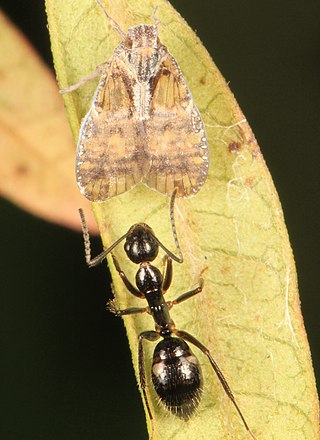
Passalidae is a family of beetles known variously as "bessbugs", "bess beetles", "betsy beetles" or "horned passalus beetles". Nearly all of the 500-odd species are tropical; species found in North America are notable for their size, ranging from 20–43 mm, for having a single "horn" on the head, and for a form of social behavior unusual among beetles.

The eastern cottontail is a New World cottontail rabbit, a member of the family Leporidae. It is the most common rabbit species in North America.

Carpenter ants are large ants indigenous to many forested parts of the world.

Wagner's bonneted bat or Wagner's mastiff bat, is a species of bat in the family Molossidae. It is found in the Americas from Argentina and Peru north to Mexico, and Cuba. Populations in Florida in the United States are now recognized as the Florida bonneted bat

Tremarctos floridanus, occasionally called the Florida spectacled bear, Florida cave bear, or rarely Florida short-faced bear, is an extinct species of bear in the family Ursidae, subfamily Tremarctinae. T. floridanus was widespread in the Southeastern United States during the Rancholabrean epoch, with scattered reports of fossils from other parts of North America and from earlier epochs.

Camponotus atriceps, previously referred as C. abdominalis, is a species of carpenter ant, endemic to the Americas.
Nothomicrodon aztecarum is a species of Neotropical flies, originally described from a larva collected in 1924 from a carton nest of the ant Azteca trigona. It is the only species in the genus Nothomicrodon, but shows none of the features of a hoverfly larva, the family in which it was originally classified, and instead belongs in the family Phoridae.

Ectatomma ruidum is a Neotropical species of ant in the subfamily Ectatomminae.
The Alachua Formation is a Miocene geologic formation in Florida. The claystones, sandstones and phosphorites of the formation preserve many fossils of mammals, birds, reptiles and fish, among others megalodon.

Camponotus floridanus, or Florida carpenter ant, is a species of ant in the genus Camponotus. First described as Formica floridana by Buckley in 1866, the species was moved to Camponotus by Mayr in 1886. The ant is widespread in Florida and occurs as far north as North Carolina and as far west as Mississippi.

Tetramorium hispidum is a species of ant in the subfamily Myrmicinae. Tetramorium hispidum differs from similar ants in the Myrmicinae subfamily by the structure surrounding the ant's antennal insertions. Short, stubble-like hairs exist on the pronotum and frontal carinae. The antenna of Tetramorium hispidum contains 11 segments.

Aphaenogaster uinta is a species of ant in the family Formicidae.

Camponotus sexguttatus is a species of ant in the family Formicidae.

Camponotus planatus, known generally as the compact carpenter ant or short carpenter ant, is one of three Camponotus species that is polygynous, or has more than one queen. It is a species of ant in the family Formicidae.

Pheidole metallescens is an ant, a species of higher myrmicine in the family Formicidae.

Trachymyrmex nogalensis is a species of higher myrmicine in the family Formicidae.

Camponotus quercicola is a species of ant in the family Formicidae that is endemic to California and commonly nests in oak trees, as they usually inhabit oak forests.

Pseudochalcura gibbosa is a species of chalcid wasp in the family Eucharitidae. It is associated with ants from the Camponotus genus.

Xenomyrmex floridanus is a species of ant in the family Formicidae.
Phoenicopterus floridanus is an extinct species of flamingo that lived during the Pliocene in what is now Florida and potentially North Carolina.
















